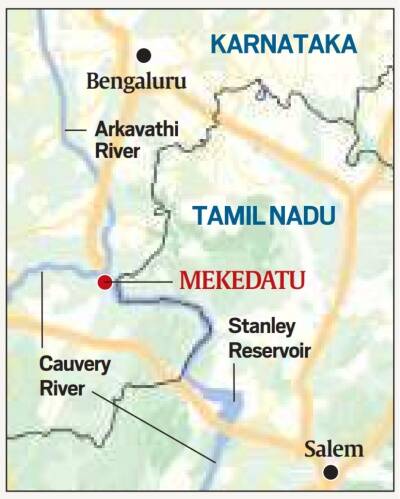CURRENT AFFAIRS
Get the most updated and recent current affair content on Padhaikaro.com
Mekedatu Project Controversy
- Vaid's ICS, Lucknow
- 26, Mar 2022

Why in News?
- Karnataka and Tamil Nadu are heading for a political confrontation over the Mekedatu drinking water project across river Cauvery.
Mekedatu Project
- Originally mooted in 1948: Mekedatu is a drinking water cum power generation project across river Cauvery.
- Location: Proposed by Karnataka, the project envisages a reservoir near Ontigondlu, about 1.5 km from Mekedatu in Ramanagara district of south Karnataka at the confluence of the Cauvery and Arkavathi rivers.
- It is 4 km from the Tamil Nadu border and 100 km from Bengaluru.
- Cauvery Water Disputes Tribunal: Karnataka gave the project shape after the final award of the Cauvery Water Disputes Tribunal was notified in 2013 allocating the riparian states their shares.
- Cost: The project cost is estimated at Rs 9,000 crore.
Issues associated with the project
- Multiple clearances: The project will need multiple clearances from the Centre and courts as it involves the Cauvery water sharing dispute.
- Affects Natural Habitats: The proposed land for the submergence zone is habitats for certain threatened species. The project will be adversely impacting their natural habitat.
Tussle with Tamil Nadu:
- Tamil Nadu had all along strongly opposed the project and approached the Supreme Court as well saying any dam proposal by upper riparian states in the Cauvery basin would deprive the state’s delta farmers of their rightful share of water.
- The state contended that the proposed reservoir would affect the natural flows of the river Cauvery and nullifies the final adjudication of the settlement of the centuries-long Cauvery river dispute through the formation of the Cauvery Water Regulation Committee.
- Karnataka has maintained that the extra drawing of water will not, in any way, affect the mandatory allocation of water to Tamil Nadu and Puducherry.
- Karnataka says: The project falls inside the jurisdictional limit of Karnataka and Tamil Nadu’s permission is not needed.
- It also argues that since there is no stay in any court for the project, Karnataka can go ahead.
- On utilizing the surplus water: Karnataka says that any allocation in this sphere should be done after hydrology studies to ascertain the quantum of excess water available in the basin.
Significance of the project
- It aims to supply drinking water to Bengaluru and surrounding regions but has been challenged in the Supreme Court by Tamil Nadu on the ground that it would eat into the state’s share of Cauvery water as adjudicated by the court in 2018.
- It would be able to help the city address its water woes.
- Currently, more than 30% of Bengaluru is dependent on borewell water.
- There are also plans to generate 400 MW of power: The revenue earned from power generation is expected to compensate the Government for its investment on the project within a few years.
Benefits of Construction of Dams
- Flood control: Water bodies like dams decrease or eliminate the flood effects.
- Land improvement: are the extra benefits that will occur after an increase in the soil productivity because of drainage and land improvement precautions.
- Potable Water: Dams supply drinking water and domestic water to address water scarcity.
- Irrigation: Dams benefit the dry and unirrigated regions.
- Energy: Dams provide energy benefit and make the project more economical with additional value.
- Transportation benefits: They will occur in case there is waterway transportation in the project.
Environmental Impacts of Dams
- Destruction of Nature: The water regime may change as a result of destruction of nature, unexpected floods may occur and consequently vegetation and natural structures in the riverbanks can be damaged.
- Affects Fauna: Normal passing ways of territorial animals are hindered since the dam works as a barrier. The fishes can be damaged while passing through the floodgates, turbines and pumps of the high bodied dams.
- Rehabilitation: Dams affect the social, cultural and economical structure of the region considerably. Especially forcing people, whose settlement areas and lands remain under water to migrate, affect their psychology negatively.
- Loss of Aesthetic Beauty: The geological and topographical places that are rare with their exceptional beauties, disappear after lying under the reservoir.
- Chances of Earthquakes: Some increase in earthquakes may occur because of filling of big dam reservoirs.
Facts for Prelims :
5-95-95 Strategy:
- The Joint United Nations Programme on HIV/AIDS aims for HIV testing, treatment and viral suppression rates to be 95%–95%–95% by 2025.
- Earlier, it was 90-90-90 Strategy. It calls for 90% of HIV-infected individuals to be diagnosed by 2020, 90% of whom will be on anti-retroviral therapy (ART) and 90% of whom will achieve sustained virologic suppression by 2020.